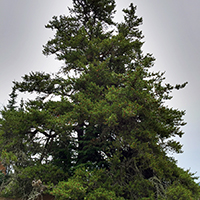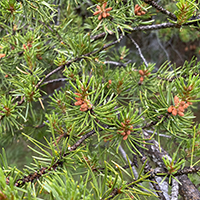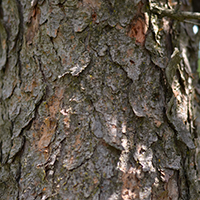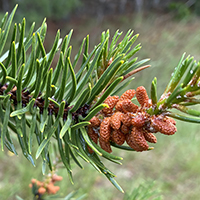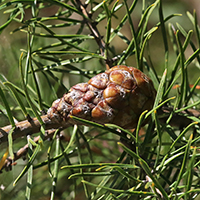What jack pine looks like
Size and shape
- Reaches 20 metres high.
- Trunk up to 50 centimetres in diameter.
Needles
- Yellowish-green needles grow in bundles of 2 (2 to 4 centimetres long).
- Needles are sharp, stiff and spread apart.
Bark
- Thin and reddish-brown to grey when young.
- Becomes furrowed with thick plates and dark brown with age.
Flowers
- Male cones are cylindrical and grow in dense clusters (less than 2 centimetres).
- Female cones are cashew-shaped and pinkish on a short stalk (less than 1 centimetre), brown in colour later turning to grey.
Fruit
- Seed cones have 80 scales, are yellowish-brown and grow in clusters of 2 or 3 (3 to 7 centimetres).
- Open when exposed to heat from forest fires.
Where jack pine is found
Jack pine is found across Ontario.
What you need to know to grow jack pine
- Moisture: grows best in dry soil.
- Soil: commonly found on sandy soils, and shallow soil over bedrock.
- Shade: requires full sun.
- Caution:
- jack pine budworm is a forest defoliating insect. Larvae feed inside male flowers and on developing needles, resulting in browning foliage across the forest. This defoliation can lead to reduced growth and tree mortality. During severe outbreaks, a bacterial spray is applied to highly valued stands to control the spread of jack pine budworm.
Benefits and uses of jack pine
Wildlife benefits
Jack pine trees provide food for many species, including:
- white-tailed deer
- porcupines
- snowshoe hares
Young jack pine stands also provide cover and nesting sites for birds, such as the endangered Kirtland’s warbler.
Commercial uses
Jack pine wood is a softwood commonly used for:
- pulp and paper
- boxes and crates
- poles
- construction lumber
Current research
To learn about our research on jack pine, visit our science publications catalogue and search for “jack pine.”
Fun facts about jack pine
- Jack pine trees can live to 150 years.
- Jack pine is the most widely distributed tree in Canada.
Updated: January 10, 2024
Published: July 18, 2014
